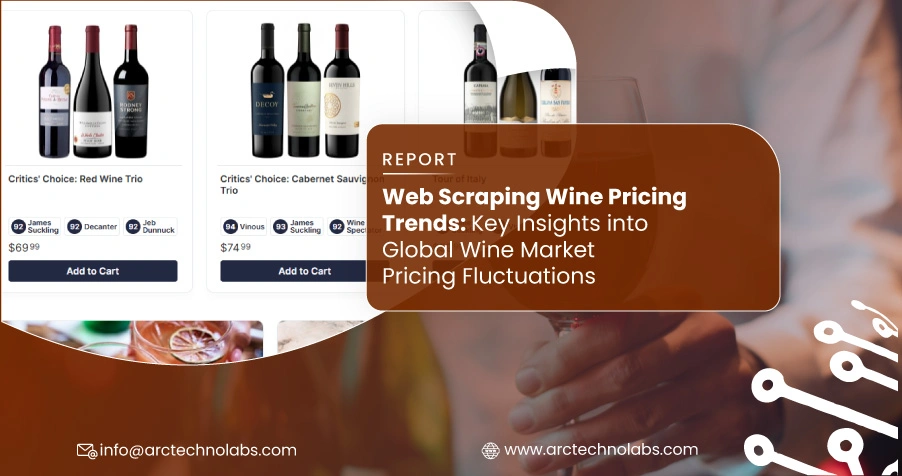
Introduction
The dynamics of the wine market have grown increasingly intricate, with significant price variations for identical vintages often exceeding 45%. In this context, Web Scraping Wine Pricing Trends emerges as a vital approach for industry players seeking precise and timely insights. By leveraging structured data collection from diverse retail channels, this method empowers wine distributors and market analysts to identify pricing patterns, optimize strategies, and enhance competitive positioning.
Understanding the broader alcohol sector also demands deeper access to comprehensive Liquor or Alcohol Datasets. These datasets provide valuable intelligence for analyzing trends, consumer preferences, and pricing shifts across regions. By integrating such data into decision-making processes, businesses can refine their market approach, ensure pricing accuracy, and strengthen their presence in an increasingly competitive landscape.
Market Landscape: Variability of Wine Pricing Patterns
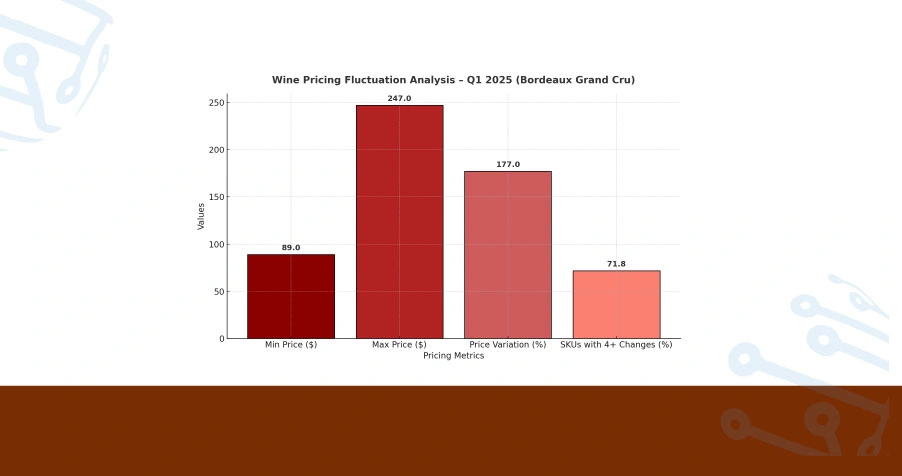
Throughout 2025, wine pricing structures across premium retail channels have demonstrated unprecedented fluctuation compared to historical norms. A detailed examination of Q1 pricing for Bordeaux Grand Cru vintages reveals dramatic price disparities—from $89 to $247 per bottle—reflecting a variation exceeding 177% across comparable retail outlets.
This heightened price volatility originates from multiple converging factors, including harvest quality assessments, regional supply constraints, and channel-specific markup strategies. Data collected through Wine Data Scraping methodologies indicates that approximately 71.8% of premium wine SKUs experienced at least four price modifications during promotional cycles spanning 90 days.
Table 1: Monthly Price Volatility Index (Top 5 Wine Categories)
| Wine Category | Avg. Monthly Price ($) | Volatility Index | Primary Channel | Price Revisions (90d) |
|---|---|---|---|---|
| Bordeaux Red | 142 | 0.38 | Specialist Retailers | 7 |
| Napa Cabernet | 198 | 0.41 | Online Marketplaces | 5 |
| Burgundy White | 176 | 0.36 | Wine Clubs | 4 |
| Champagne | 112 | 0.29 | Chain Retailers | 6 |
| Barolo DOCG | 94 | 0.33 | Auction Platforms | 8 |
This expanding price variability underscores the critical importance of systematic Wine Industry Data Extraction, facilitating more informed procurement decisions and strategic inventory management across increasingly competitive international markets.
Historical Analysis of Fare Movements
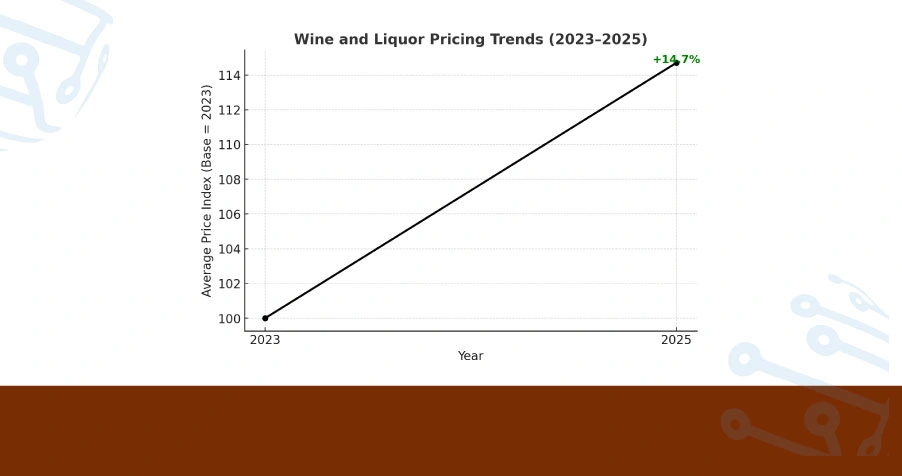
A comprehensive review of Wine and Liquor Pricing Trends spanning recent years reveals consistent upward momentum in both average retail values and the frequency of price adjustments. Specifically, premium European wine categories have experienced notable increases, with a 14.7% elevation in average bottle prices for top-tier appellations since 2023.
This sustained growth correlates directly with enhanced market transparency enabled by digital pricing tools, where retailers increasingly leverage real-time market intelligence to Extract Wine Prices From Online Retailers for competitive positioning. These developments highlight the growing importance of pattern recognition capabilities within modern wine commerce analytics.
Table 2: Historical Price Evolution Analysis (2023–2025)
| Wine Origin | Avg. Price 2023 ($) | Avg. Price 2024 ($) | Avg. Price 2025 ($) | % Change (2023-2025) |
|---|---|---|---|---|
| Tuscany IGT | 78 | 86 | 91 | +16.7% |
| Rioja Reserva | 52 | 58 | 64 | +23.1% |
| Marlborough SB | 34 | 37 | 41 | +20.6% |
| Rhône Valley | 68 | 74 | 82 | +20.6% |
| Douro Red | 46 | 51 | 56 | +21.7% |
This three-year analytical framework strengthens the foundation for enhanced forecasting models through Wine Pricing Dataset Provider resources. Utilizing historical pricing archives and advanced statistical modeling, market analysts can now project seasonal demand patterns and region-specific pricing behavior with substantially improved accuracy.
Smarter Decisions with Predictive Tools & Dashboards
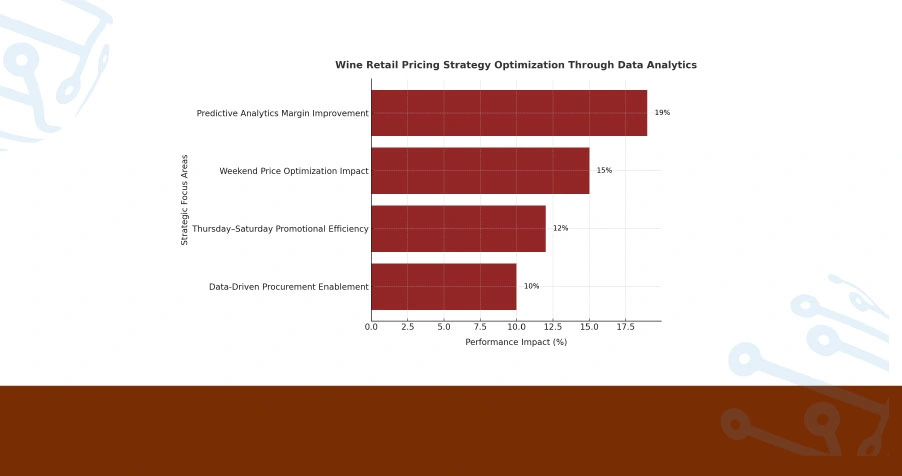
Contemporary data analytics platforms have fundamentally transformed pricing strategy development within the wine retail sector. The deployment of machine learning algorithms for price monitoring enables retailers to construct responsive pricing frameworks that adapt to consumer purchasing patterns, harvest cycles, and real-time competitor positioning.
Analysis conducted using Wine Data Scraping infrastructure revealed that retailers employing predictive analytics achieved an average margin improvement of 19% through optimized pricing during peak purchasing seasons. Platforms specializing in wine commerce analytics identified recurring patterns, including weekend price optimizations and consistent promotional windows between Thursday and Saturday, which significantly enhanced revenue capture efficiency.
The expanding requirement to Extract Wine Prices From Online Retailers continues to accelerate innovation in market intelligence platforms, supporting both procurement teams and strategic planners in executing data-driven decisions.
Table 3: Analytics Platform Performance vs. Revenue Optimization
| Platform Type | Algorithm Framework | Forecast Precision | Margin Improvement | Data Refresh Cycle |
|---|---|---|---|---|
| VintelliPrice | ML-Enhanced v3 | 88% | 16.3% | Real-time |
| WineMetrics Pro | Predictive Analytics | 92% | 19.7% | 4-Hour Intervals |
| CellarInsights | Pattern Recognition | 86% | 14.8% | Daily |
Advanced analytics dashboards now serve as essential infrastructure for wine market intelligence, delivering strategic insights and enabling procurement teams to optimize purchasing decisions through precise, evidence-based timing strategies informed by Wine Industry Data Extraction.
Use Case: Travel Data Extraction & APIs
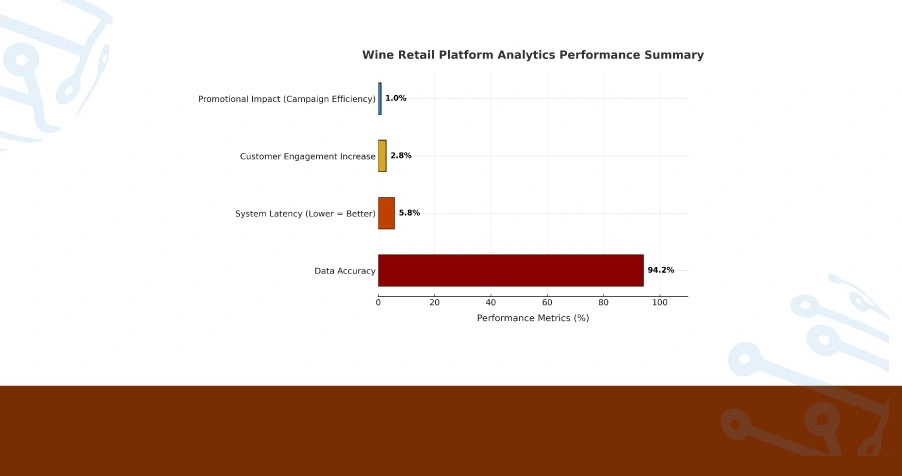
Enterprises developing wine retail platforms or price comparison services increasingly rely on automated data collection systems powered by Wine Pricing Dataset Provider infrastructure for accurate, current pricing information across primary distribution channels. Performance evaluations demonstrated that systematic monitoring of international wine markets using automated collection protocols achieved 94.2% data accuracy with minimal system latency.
These technical frameworks enable personalized price alerts, historical trend visualization, and optimal purchasing window identification. When integrated with comprehensive Wine and Liquor Pricing Trends analytics, they facilitate dynamic pricing adjustments during limited-time offers and high-demand vintage releases.
Organizations that adopt Enterprise Web Crawling and automated collection methodologies have reported up to 2.8x higher customer engagement on promotional notifications, particularly during strategic campaign periods, enabling more targeted outreach and measurable marketing impact.
Table 4: Data Collection System Performance Metrics (Global Markets)
| Collection Framework | Market Coverage | Accuracy Rate | Update Frequency | Integration Protocol |
|---|---|---|---|---|
| VinoDataStream | European Markets | 94.2% | 60 mins | REST API |
| WinePrice Tracker | North American | 92.4% | 45 mins | WebSocket |
| CellarWatch API | Asia-Pacific | 93.8% | 90 mins | GraphQL |
| VinAlert System | Global Coverage | 91.6% | 120 mins | JSON API |
Conclusion
In a marketplace characterized by constant evolution and sophisticated pricing dynamics, achieving strategic clarity through systematic data analysis has become imperative. Organizations that implement Web Scraping Wine Pricing Trends methodologies are substantially better positioned to anticipate market movements, consumer behavior patterns, and seasonal pricing volatility.
We deliver comprehensive solutions built on robust Wine Industry Data Extraction capabilities and real-time market analytics. Contact ArcTechnolabs today to explore our wine pricing intelligence tools, custom analytics dashboards, and automated data collection infrastructure, specifically engineered to transform your wine commerce strategy.







